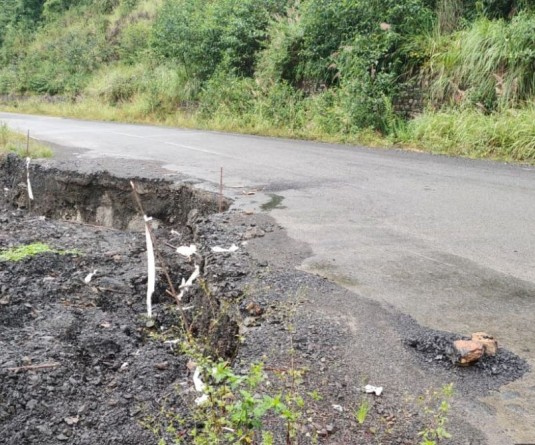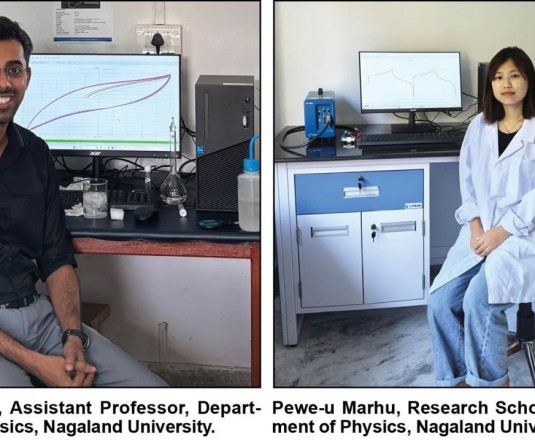
Indigenous agri methods promote agro biodiversity
Morung Express Feature
Phek | March 26
On an early morning of early March, a group of Gorkha farmers—from the Lepcha and Subbah communities of Kalimpong district, West Bengal—are on a visit to Chakhesang terrace paddy fields in Enhulumi village, Phek district.
But it is not the terrace fields that hold the fancy of the guests. It is the uncultivated biodiversity that grows alongside the wet and dry terrace paddy fields that fascinate them—some herb is a cure for kidney diseases, another for stomach ailments; snails, fish and frog have their own stories.
Two women farmers from Enhulumi village showing us around know the local details of every plant; what can be eaten, what not, for what, when, how. They teach us about the Enhulumi community’s water sharing system. They point to a distant hill and show us how their jhum fields are used by the community to grow local plums that have become a market hit.
The North East Network (NEN) Nagaland’s Wekowe-u Tsuhah is facilitating the farmers-field-meet as part of their exposure tour after a Biodiversity Festival on March 8, 2017. Accompanying us are women farmers from the East Khasi Hills who lose no time in emulating their Naga counterparts in current soil-breaking methods on dry terrace paddy fields.
At the Festival, they had exchanged indigenous seeds with farmers from Mesulumi village, Phek district. Most of their seeds will be planted on jhum fields. The group of visiting farmers is thus led to one of neighbouring Chizami’s jhum fields—slipping and sliding down the steep, still dry, slope, we reach Adile Wezah’s (53) field hut.
“I have millets, maize, banana, papaya, ginger, beans,” and a whole lot of other crops, lists Wezah who is accompanied by her sister-in-law on the field. NEN Nagaland’s Dolly Wotsa and Stephen Gangmei are facilitating the jhum field meet. Climbing a bit more down the slope, the farmers demonstrate how seeds are sown and covered with soil before the rains set in.
“We get to eat nutritious food without buying anything from the market. We share our produce with the church and the elderly. I even pay my children’s tuition fee from the surplus,” informs Wezah about the gains she makes from her field.
She has been tending to this patch of jhum field since 2009 and the soil still remains greatly productive. This piece of land belongs to her husband’s clan, she says. Her father had also gifted her some ancestral land but this was taken away by male clan elders who could not fathom giving traditional land to a woman no matter how much back breaking, sun burning, work she put into it.
Wezah made a different form of investment thus. She maintains her own bank of seeds that were passed on to her by her foremothers. “I try to keep growing even unprofitable crops just so that our ancestral seeds can be preserved,” she tells us, pointing to a tiny patch of local cotton which is not enough for her to make use of in the short run. In the long run though, this is a rich repository of knowledge.
The Gorkha visiting farmers are acutely aware of this. As they pop some corn seeds in a cooking pot at Wezah’s field hut, munching pineapples and papaya from the field, they are awe struck by the agricultural practices of Naga farmers.
“This is the first time we have seen jhum kheti,” says Binesh Rai (39) who was leading a team of 8 women farmers from two villages in Kalimpong: Barbot village (Subbah community) and Primtam village (Lepcha community). “We mostly do terrace paddy cultivation, if at all. Our young people have left villages en masse, leaving only the old to tend to fields. With large scale cash crop plantations for years, like cardamom or ginger, our soil is becoming disease-borne, degrading and dying slowly,” he explains.
His team finds it “amazing” that cultivators here do not use “non organic manure” and how indigenous agriculture methods have helped maintain the rich agro biodiversity in these hills. The excessive use of pesticides and “big is great” developmental aspirations in Kalimpong hills, says Rai, have led to quick bucks for a few villages; however, they are now seeing more instances of cancers among adults, and mental and physical deformities in new borns.
While the Gorkha farmers exchanged seeds with Nagaland’s farmers, Rai has a word of caution. “It is better to test seeds from our region on a small patch of land, or get them tested by scientists for diseases,” he warns, even as he tips us on Ebony and Mahogany chutney recipes for curing certain ailments of the stomach.
As the peach and plum blossoms reached their final phase, the farmer knowledge exchange in Phek district opened up new avenues of thought and collaboration. Next year awaits greater dividend.





